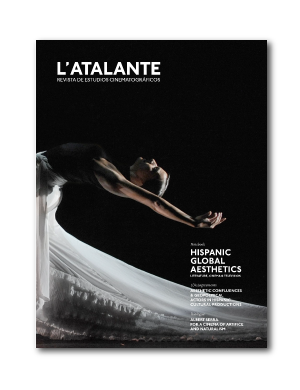Published 2018-07-31
Keywords
- Guerín,
- Memory,
- Montage,
- Deleuze,
- Postmodernity
- Memories,
- Aesthetic,
- Storytelling. ...More
How to Cite
Copyright (c) 2018 L'Atalante. Journal of film studies

This work is licensed under a Creative Commons Attribution-NonCommercial-NoDerivatives 4.0 International License.
Abstract
This article offers an exploration of José Luis Guerín’s key work, Tren de Sombras [Train of Shadows] (1997), reflecting on the concept of memory and its manifestation in the cinematic language of this filmmaker, focusing on the idea of montage, time and space. Thus, based on an analysis of a sequence of the film and taking post-modern discourse on memory and space as our reference, we attempt to relate Guerín’s work and discourse on filmed memory with the postulates of Gilles Deleuze and his reinterpretation of the work of Bergson. In this way, the objective of this study of memory, along with the concepts associated with the so-called new narrative, may acquire a stronger conceptual dimension and shed light on the director’s work in the interests of a continued vindication of Guerín’s role as an exponent of the experimental avant-garde in contemporary cinema.
Downloads
References
Asenjo Conde, D. (2013). Fados. Representaciones fílmicas de una Iberia reunida. En R. Lefere (ed.), <em>Carlos Saura, una trayectoria ejemplar </em>(pp. 181-215). Madrid: Visor Libros.<br>
Bloch-Robin, M. (2011). <em>Théorie et pratique de la musique vocale au cinéma: L’œuvre de Carlos Saura. </em>Tesis doctoral. París: Université Paris-Est.<br>
Calabrese, O. (1999). <em>La era neobarroca</em>. Madrid: Cátedra.<br>
D’Lugo, M. (1991). <em>The Films of Carlos Saura: The Practice of Seeing</em>. Princeton: Princeton University Press.<br>
—(2010). Aural Identity, Genealogies of Sound Technologies and Hispanic Transnationality On Screen. En K. Newman y N. Durovicova (eds.), <em>World Cinemas, Transnational Perspectives</em> (pp. 160-186). Nueva York: Routledge.<br>
Díaz López, M. (2015). Aproximación a la distribución internacional de cine español en los inicios del siglo XXI. <em>Studies in Spanish & Latin American Cinemas, </em>12 (3), 255–277. https://doi.org/10.1386/slac.12.3.255_1.<br>
Gómez González, Á. C. (2002). <em>La reconstrucción de la identidad del flamenco en el cine de Carlos Saura.</em> Sevilla: Consejería de Relaciones Institucionales.<br>
Haverty-Rugg, L. (2005). Globalization and the Auteur: Bergman Projected Internationally. En A. Nestingen y T. K. Elkington (eds.), <em>Transnational Cinema in a Global North </em>(pp. 221-241). Detroit: Wayne University Press.<br>
Hjort, M. (2010). On the Plurality of Cinematic Transnationalism. En K. Newman y N. Durovicova (eds.), <em>World Cinemas, Transnational Perspectives</em> (pp. 12-33). Nueva York: Routledge.<br>
Jameson, F. (1995). <em>La estética geopolítica. </em>Barcelona: Paidós.<br>
Jullier, L. (1997). <em>L’ecran post-moderne: un cinéma de l’allusion et du feu d’artifice. </em>París: L’Harmattan.<br>
Lefere, R. (2012). El cine de Carlos Saura, más allá de los estereotipos. En N. Lie, S. Mandolessi y D. Vandebosch (eds.), <em>El juego con los estereotipos </em>(pp. 209-219). Bruselas: Peter Lang.<br>
Palacio, M. (1983). La obra de Carlos Saura en la crítica especializada española. <em>Actes du Colloque sur le cinéma de Carlos Saura</em>, 49-65. Burdeos: Université de Bordeaux.<br>
Sánchez Vidal. A. (1986). El cine de Carlos Saura: tipología de una recepción. <em>Artigramas</em>, 3, 369-383.<br>
—(1988). <em>El cine de Carlos Saura. </em>Zaragoza:Caja de Ahorros de la Inmaculada.<br>
Saramago, J. (1990). Sobre el iberismo y otros escritos de literatura portuguesa (prólogo). En Molina, C. A. <em>Sobre el iberismo y otros escritos de lengua portuguesa</em> (pp. 5-9). Madrid: Akal.<br>
Smith, P. J. (2012). Transnational Cinemas. The Cases of Mexico, Argentina and Brasil. En L. Nagib, C. Perriam y R. Dudrah (eds.), <em>Theorizing World Cinema </em>(pp. 63-76). Londres: I.B. Tauris.<br>
Thibaudeau, P. (2007). Del repertorio musical y coreográfico al repertorio cinematográfico: el caso de Carlos Saura. <em>Pandora. Revue d’études hispaniques</em>, 7, 21-30.<br>
—(2013). Las películas musicales de Carlos Saura, un espacio abierto a la reflexión cinematográfica. En C. Rodríguez Fuentes (ed.), <em>Desmontando a Saura</em> (pp. 229-243). Madrid: Luces de Gálibo.</p>

